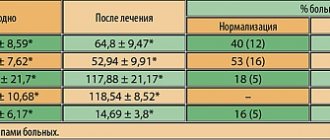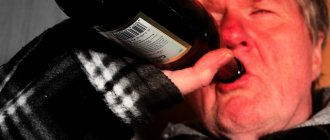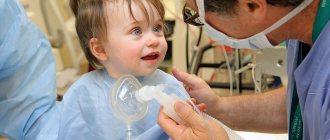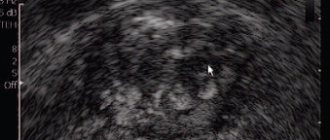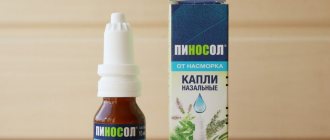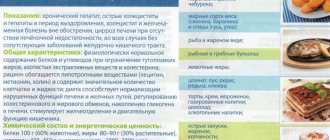Use of the drug Prolit in patients with cholelithiasis in combination with urolithiasis
The problem of modern diagnosis and treatment of cholelithiasis (GSD) has not yet been completely resolved and attracts the attention of a wide range of practitioners and researchers.
Table 1. Dynamics of clinical symptoms in patients of group I before and after treatment with Prolit
Table 2. Dynamics of clinical symptoms in patients of group II before and after use of the drug Prolit
Table 3. Study of the contractile function of the gallbladder before and after treatment
Table 4. Dynamics of gallbladder “sediment” in the studied patients
Table 5. Ultrasound dynamics in patients with urolithiasis
Conservative treatment of cholelithiasis, in addition to cholekinetics and antispasmodics, also includes litholytic drugs of the henooxycholic and ursodeoxycholic acid group (Chenofalk, Ursofalk and their other analogues) (1, 2). At the same time, for effective dissolution, it is necessary that the stones are only soft cholesterol ones, and their size does not exceed 15-20 mm when the gallbladder is filled no more than half and the bile ducts fully retain their function. The greatest effect is achieved by combined treatment of patients with cholelithiasis with cheno- and ursodeoxycholic acids. Combination therapy (5-6 mg/kg urso- and 5-10 mg/kg chenodeoxycholic acids) promotes faster dissolution of cholesterol gallstones than the use of each of these acids separately. After 12 months complete dissolution of stones is observed in 50-65% of patients (1, 2). However, the effect of cholelitic therapy is temporary, leading to relapse of cholelithiasis in some patients after cessation of treatment (2). In addition, there are currently no effective methods for dissolving gallstones that contain large amounts of calcium and/or bile pigments (3). In this regard, alternative methods for the prevention and treatment of diseases of the gallbladder and biliary tract are relevant.
Currently, in Russia, the dietary supplement Prolit, produced by , has begun to be used as an adjuvant in the treatment and prevention of cholelithiasis. The plant complex contains extracts of curly silkworm leaves, papaya, field sow thistle, phyllanthus niruri, cubeba pepper fruits, imperata cylindrical rhizomes, kidney tea herb in minimal dosages. The main component of the Prolit dietary supplement is curly silkworm extract (5), which has the property of destroying stones in the kidneys and urinary tract, gall bladder and bile ducts, in the latter case - stones of various sizes and biochemical composition. This property of the plant allows one to achieve good results in urolithiasis and cholelithiasis (4).
Purpose of the study:
to evaluate the clinical effectiveness and safety of the use of the drug Prolit in patients with urolithiasis (KSD) in combination with the initial stage of cholelithiasis.
Research objectives:
- to evaluate the effect of the drug Prolit on the dynamics of clinical symptoms of urolithiasis and cholelithiasis according to an individual diary during a course of monotherapy with the drug;
- evaluate the effect of the drug on the contractility of the gallbladder and the functioning of the sphincter apparatus according to ultrasound data in response to a food breakfast before and after using the drug;
- evaluate the litholytic effect of the drug according to ultrasound data;
- evaluate the effect of the drug on bile homogeneity according to ultrasound data in patients with calculous cholecystitis;
- establish an effective dose of the drug.
Materials and methods
A total of 30 patients with urolithiasis in combination with cholelithiasis (including those with the initial stage) were accepted for the study and were divided into 2 groups.
Group I consisted of 15 patients: 7 women and 8 men, whose average age was 56.6 ± 2.56 years. Stones of the pelvis and calyces of the left kidney were detected in 7 patients (in 6 patients - up to 0.4-0.6 cm, in one - a stone measuring 23 mm), of the right kidney - in 6, in one patient bilateral stones of the cerebral palsy were observed, and in another In one patient, no stones were detected by ultrasound, but enlargement of the lumbar region and dilatation of the urinary tract were observed. Sediment in the gallbladder (GB) was present in 13 patients, one patient had small gallstones in combination with sediment, and another patient had small cholesterol gallstones without sediment.
Group II consisted of 15 patients: 8 women and 7 men, average age – 61.7 ± 3.4 years. Stones of the pelvis and calyces of the left kidney were determined in 9 patients (in 8 patients - up to 0.4-0.6 cm, in one patient - a stone measuring 20 mm), stones of the right kidney - in 2 patients, bilateral - in 4 patients (in In one patient, microliths were combined with a large calculus measuring 18 mm in the right kidney).
There was sediment in the gallbladder in 12 patients, and small stones in 3.
The groups were comparable by gender and age. The drug was used for three months. Group I patients took Prolit at a dose of 1 capsule 3 times a day; patients of group II – 2 capsules 3 times a day.
The criteria for assessing the effectiveness and tolerability of Prolit dietary supplements were:
- dynamics of clinical symptoms;
- dynamics of contractile function of the gallbladder according to ultrasound data.
Research results and discussion
Patients in both groups complained of pain in the upper and lower abdomen. The dynamics of clinical symptoms in group I are presented in Table 1. Pain in the upper abdomen was observed in 13 of 15 patients in group I (86.7%). The pain was predominantly localized in the right hypochondrium; in half of the patients it was moderate or severe. In all patients, the pain was paroxysmal, occurred after eating, and was provoked by eating fatty or fried foods. In 5 patients, pain radiated to the back and iliac region. Pain in the lower abdomen and lower back was observed in 11 of 15 patients in group I (73.3%). In 6 patients the pain was paroxysmal in nature, in 5 it was almost constant (moderate and weak) in the lumbar region.
The data is presented in Table 1.
From the presented data it is clear that against the background of a three-month course of using the drug Prolit, patients in group I showed positive changes in clinical symptoms: by the end of therapy, pain in the upper abdomen was relieved and did not recur in 4 (26.7%) of 13 patients (86 .7%), positive dynamics in terms of intensity, duration and frequency of recurrence of painful attacks were noted in 6 (46.1%) of 13 patients (86.7%). In three patients no positive dynamics were noted (20%). In 3 patients with renal colic (20%), pain in the lower abdomen was relieved during therapy and did not recur during the observation period; in 8 patients no significant dynamics were noted.
In group II, pain in the upper abdomen was recorded in 8 out of 15 patients (53.3%), pain in the right hypochondrium of moderate intensity predominated, and in two patients it radiated to the back. In all patients, the pain was paroxysmal in nature and was associated with food intake. Pain in the lower abdomen was observed in 7 of 15 patients in group II (46.7%). In 6 patients, the pain was paroxysmal in nature; one patient had constant moderate pain in the left lumbar region.
The dynamics of clinical symptoms in group II are presented in Table 2.
From the presented data it is clear that against the background of a three-month course of using the dietary supplement Prolit in a dose of 2 capsules 3 times a day, positive changes in clinical symptoms were noted in patients of group II. By the end of therapy, pain in the upper abdomen was relieved and did not recur in 5 (33.3%) of 8 (53.3%) patients; positive dynamics (decreased frequency and intensity of pain) were observed in one patient (6.7%) , 2 patients showed no dynamics (13.3%). Pain in the lower abdomen was relieved (and did not recur later) in all patients by the end of the first month of therapy. As can be seen from the presented data, the effectiveness of the drug in relation to clinical symptoms in group II was higher compared to group I. Data from studying the contractile function of the gallbladder before and after using the drug are presented in Table 3.
In group I, the initially reduced contractile function of the gallbladder was restored in 3 of 8 patients (37.5%). In group II, after using the drug, the contractile function of the gallbladder was restored in 5 out of 9 patients (55.6%). Ultrasound examination data of the gallbladder are presented in Table 4.
Sediment in the gallbladder was observed in 14 patients of group I: in one patient - sediment + small cholesterol stones. Another patient had small cholesterol stones without sediment in the gallbladder.
In 5 of 14 (35.7%) patients, by the end of the course of using the drug Prolit, no sediment was found in the gallbladder; in one (7.1%) patient, positive dynamics were noted by the end of the course of therapy in relation to the volume of sediment.
Sediment in the gallbladder was observed in 12 patients of group II, three had small cholesterol stones.
After the end of use of the drug, sediment remained in 5 patients, in 7 (58.3%) no sediment was detected. The GB stones in two patients remained the same size (0.4-0.8 cm); in one patient, who initially had 2 small stones, one stone in the GB (0.5 cm) was not found during control. Data from ultrasound examination of the urinary system in patients of groups I and II are presented in Table 5.
As can be seen from the presented data, in group I, during therapy, the release of stones from the cervical spine was observed in two out of 14 patients (14.3%). In patients of group II, dissolution of microliths was observed in 10 patients (66.7%), of which 8 - during the first month of therapy. Two (13.3%) patients showed positive dynamics: the disappearance of small stones with the preservation of large ones (18 mm) in one patient and a decrease in the size of a large stone (23 mm) to 0.8 cm in the second patient. Three (20%) patients (with stones 0.4-0.6 cm) showed no dynamics.
Adverse events
No allergic reactions were noted. Two patients of group I and one patient of group II had renal colic when stones passed. Subsequently, the pain did not recur.
Conclusion
The combination of urolithiasis and cholelithiasis is not uncommon in clinical practice, and it seemed interesting to us to evaluate the effect of the Prolit dietary supplement in such patients. As a result of the clinical study, the positive effect of the drug Prolit on the clinical course of the disease in patients with the initial stage of cholelithiasis was proven: pain was relieved or decreased in 10 (13) patients of group I (76.8%) and in 6 (8) patients of group II ( 75%).
According to instrumental data, the contractile function of the gallbladder was restored in 3 (8) patients of group I (37.5%) and 5 (9) patients of group II (55.6%).
Positive dynamics regarding the volume of sediment in the gallbladder was achieved in 6 (14) patients of group I (42.8%) and 7 (12) patients of group II (58.3%). Dissolution of a small cholesterol stone in the gallbladder was noted in one (3) patient of group II.
In patients with urolithiasis, dissolution of stones or positive dynamics in terms of their size and quantity were noted in two (14) patients (14.3%) of group I and 12 (15) patients (80%) of group II. Clinical manifestations also correspond to these data - a positive effect in relation to pain in the lower abdomen and lower back was noted in 3 (11) patients of group II (27.3%) and in 7 (7) patients of group II (100%).
Thus, Prolit can be effectively prescribed as monotherapy in patients with urolithiasis in combination with cholelithiasis.
conclusions
- Prolit is effective against clinical symptoms associated with both urolithiasis and the initial stage of cholelithiasis. With urolithiasis, the effect of the drug depends on the dose.
- The litholytic effect of the drug Prolit in patients with urolithiasis is most pronounced when using the drug in a dose of 2 capsules 3 times a day.
- The drug effectively affects the contractility of the gallbladder, which leads to the restoration of the homogeneity of the contents of its cavity in patients with the initial stage of cholelithiasis. The best effect was achieved when using the drug in a dose of 2 capsules 3 times a day. That is, in this case the effect also depends on the dose.
- In most patients, the drug does not cause side effects. In 3 patients (10%), the occurrence of renal colic was noted after starting to use the drug, which was associated with the passage of CLS stones.
Composition and release form
Prolit®
| Pills 225 mg | 1 pill (225 mg) |
| kidney tea leaf extracts (Orthosiphonis Folium) - 27.038 mg; leaves of thistle (Sonchi Folium) - 27.038 mg; curly silkworm leaves (Sericocalycis Folium) - 24.58 mg; phyllanthus niruri herbs (Phyllanthi Herba) - 24.58 mg; rhizomes of cylindrical imperata (Imperatae Rhizoma) - 12.29; cubebae pepper fruit (Cubebae Fructus) - 3.687 mg; papaya leaves (melon tree) (Caricae Folium) - 3.687 mg | |
| excipients: glucose - 98.32 mg, turmeric - 3.465 mg, sodium bicarbonate - 0.275 mg, methylparaben - 0.04 mg |
in bottles of 100 pcs.; 1 bottle in a cardboard pack.
Prolit® super capsules
| Capsules 600 mg | 1 caps. (600 mg) |
| leaf extracts of curly silkworm (Strobilanthi Folium) - 80 mg; kidney tea leaves (Orthosiphonis Folium) - 6 mg; real ginseng roots (Radix Ginseng) - 5 mg; sea horse - 5 mg; rhizomes of cylindrical imperata (Imperatae Rhizoma) - 2 mg; licorice roots (Glycyrrhizae radix) – 2 mg | |
| excipients: starch - 500 mg |
in bottles of 60 pcs.; 1 bottle in a cardboard pack.
Component Properties
Prolit® (pills No. 100)
Curly silkworm dissolves stones of various compositions, has a diuretic, hypoglycemic and laxative effect. Kidney tea (cat's whisker) has pronounced diuretic properties. The diuretic effect is accompanied by increased release of urea, uric acid and chlorides from the body. Increases glomerular filtration, improves tubular function. It is used for acute and chronic kidney diseases, accompanied by edema, albuminuria, azotemia and the formation of kidney stones; for cystitis, urethritis, gout, diabetes; for cholecystitis, cholelithiasis, heart diseases accompanied by edema. Effective during long-term use for kidney diseases. Does not cause side effects.
Phyllanthus niruri has a strong antimicrobial and diuretic effect, helping to loosen kidney stones. Sow thistle has a diuretic, choleretic, anti-inflammatory and mild laxative effect; used for bladder diseases. The fruits of cubeba pepper have a pronounced antiseptic effect that disinfects the genitourinary tract; used for the prevention and treatment of sexually transmitted diseases. The leaves and peel of green papaya fruits contain a complex of enzymes, including papain, which perfectly helps with disorders of gastrointestinal secretion, especially when it is difficult to digest proteins. These substances normalize the functioning of the hepatobiliary system, due to which stones in the liver and gall bladder dissolve.
Prolit® super capsules (capsules No. 60)
Curly silkworm dissolves stones of various compositions, has a diuretic, hypoglycemic and laxative effect. Kidney tea (cat's whisker) has pronounced diuretic properties. The diuretic effect is accompanied by increased release of urea, uric acid and chlorides from the body. Increases glomerular filtration, improves tubular function. It is used for acute and chronic kidney diseases, accompanied by edema, albuminuria, azotemia and the formation of kidney stones; for cystitis, urethritis, gout, diabetes; for cholecystitis, cholelithiasis, heart diseases accompanied by edema. Effective during long-term use for kidney diseases. Does not cause side effects. Ginseng is widely used as a tonic and general strengthening agent that helps improve mental and physical performance. The seahorse is considered in traditional medicine to be a valuable tonic and aphrodisiac. Licorice is naked. Used as an anti-inflammatory, antispasmodic, expectorant, antiallergic agent. Imperata cylindrical has diuretic and antifever properties. Used as a diuretic for inflammatory diseases of the bladder and urethra, chronic hepatitis, renal and cardiac edema.
